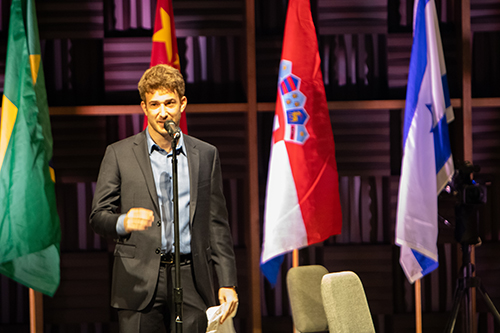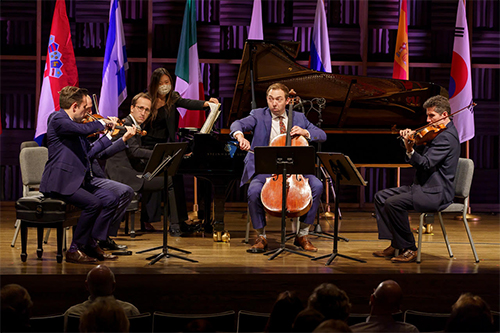by Daniel Hathaway

Thus it was that over the course of two evenings, the four finalists in the 2021 Cleveland International Piano Competition joined the Escher String Quartet onstage at Gartner Auditorium at the Cleveland Museum of Art to perform their choice of works from a list of five piano quintets.
On Tuesday, Byeol Kim chose César Franck’s Piano Quintet in f. Yedam Kim followed with Robert Schumann’s Piano Quintet in E-flat. On Wednesday, both Lovre Marušić and Martín García García selected Shostakovich’s Piano Quintet in g. (Dvořák No. 2 and Brahms, the other possibilities, went unclaimed.)
That made things interesting for the audience and jury on the one hand, and for the Escher on the other.
With different repertoire, you can find yourself comparing pommes (the very Gallic Franck) with Apfelsinen (the quintessentially Germanic Schumann). In the case of the Shostakovich, with two performances of the same work back to back, you have more direct points of comparison — but for the pianists’ collaborators there’s the added challenge of keeping two different interpretations straight.

Written in Franck’s signature, cyclic style, the work’s motifs come back a number of times during the three movements, which should cement its musical content in the listener’s memory, but — no reflection on its expert performance here — the work is curiously evanescent. By the end of intermission, it had disappeared like smoke.

The musicians took the breathtaking scherzo right out to the edge of danger without falling off the cliff. The finale, a fugue that has much in common with the last movement of Mozart’s 41st Symphony, was strong and exciting.

Martín García García plunged in head first and totally committed to his role, investing the piano part with strong emotions, even when the composer’s feelings didn’t feel completely genuine — where Shostakovich manufactured moments of happiness in a general context of bleakness and despair.

In an unusual move, García García played from a small laptop rather than a digital tablet, enlisting the aid of an assistant who poked at a key to change pages on the display.
All four pianists demonstrated strong collaborative skills which bode well for their performances on Friday and Saturday with an orchestra celebrated for playing like a big chamber ensemble. Bring the concertos on!
Photos by Gregory Wilson & Bryan Clark.
Published on ClevelandClassical.com August 6, 2021.
Click here for a printable copy of this article



